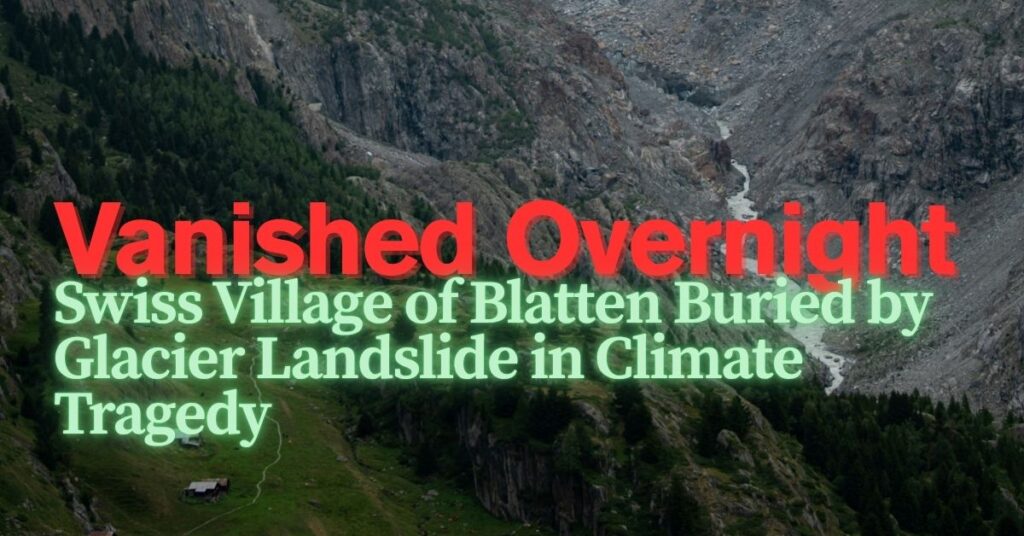A Village Lost, A Warning Ignored
It was a peaceful Alpine morning in Blatten, a postcard-perfect Swiss village nestled deep in the Lötschental Valley. Locals sipped coffee in wooden chalets, tourists wandered flower-lined trails, and the sound of cowbells echoed off the glacier-tipped peaks.
By nightfall, 90% of the village was gone.
Buried under millions of tons of ice, mud, and rock, Blatten disappeared in a “gigantic landslide” triggered by the catastrophic collapse of the Birch Glacier. What was once a sanctuary of serenity is now a desolate zone of devastation, echoing only the whir of drones and the shouts of rescue teams.
And yet, this is not just a story about a landslide.
It’s a climate emergency come to life — a tragedy decades in the making.
The Collapse: What Really Happened in Blatten?
On May 28, 2025, the Birch Glacier above Blatten gave way. Melting permafrost and relentless warming caused a massive segment of the glacier to destabilize and thunder down the mountainside.
The resulting landslide was swift and unforgiving.
- 300 residents were already evacuated in early May due to increased glacier activity.
- One person, a 64-year-old man, is still missing and feared dead.
- The Lonza River was blocked, forming a makeshift dam and threatening nearby areas with flood risk.
Swiss officials had previously warned of instability in the region, but the scale of the event exceeded all expectations.
“We knew it was a risk. We just didn’t think it would all disappear in minutes,” said Marco Lüscher, a rescue worker surveying the damage. “It’s like nature pressed delete.”

Why the Birch Glacier Collapsed: A Warming World’s Fingerprints
This disaster wasn’t just geological. It was also climatological.
Switzerland’s glaciers have been melting at record rates. In 2023 and 2024 alone, over 10% of glacial volume was lost due to unprecedented heatwaves and poor snowfall. The Birch Glacier had been visibly thinning for years, but the collapse came faster than anticipated.
Here’s what contributed:
- Accelerated glacier melt due to rising temperatures.
- Loss of Alpine permafrost, the frozen soil that acts as nature’s glue.
- Unstable slopes exposed by retreating ice.
- Heavy rainfall and freeze-thaw cycles weakening rock structures.
According to Swiss climate scientists, this kind of event could become more common — and more deadly.
Voices from the Rubble: Residents in Shock
Though most residents had been safely evacuated weeks earlier, the trauma remains etched in their hearts.
Elena Weber, a 29-year-old local schoolteacher, said:
“It’s like losing a family member. Blatten was more than a place. It was our life, our rhythm, our identity. I can’t stop hearing the sound of the mountain breaking.”
Heinrich Müller, a dairy farmer who lost his livestock and century-old home, added:
“My cows were saved, yes. But the land, the barn, the generations that came before me — all gone. I don’t know if we’ll ever come back.”
Their stories echo a chilling truth: climate change isn’t theoretical anymore. It’s local. It’s personal.
Rescue and Recovery: What Now?
Search and rescue teams, including Swiss military units and Alpine disaster response experts, were deployed immediately. But dangerous conditions and further landslide risks forced them to suspend operations after just 48 hours.
Drones now patrol the skies. Geologists monitor cracks. Hydrologists worry about the temporary lake formed behind the natural dam, which threatens to flood downstream areas if breached.
Swiss President Karin Keller-Sutter has vowed to provide relief and begin rebuilding efforts, but admits the path forward is uncertain.
“We are committed to helping the people of Blatten. But we must also confront the deeper crisis — our rapidly changing climate.”
How Much of Switzerland Is at Risk?
This isn’t the first time a Swiss glacier has collapsed, and it won’t be the last.
- In 2022, the Saas-Fee Glacier triggered a minor landslide.
- In 2023, a chunk of the Rhone Glacier broke off, damaging nearby infrastructure.
- Now in 2025, Blatten is gone.
More than 500 Alpine villages in Switzerland are considered vulnerable to landslides, rockfalls, and glacier-related disasters. Climate adaptation is no longer a choice — it’s a necessity.
Tourism and Economy: A Fragile Future
Blatten, once a thriving eco-tourism spot with chalets, ski slopes, and Alpine trails, now lies under a blanket of debris. The local economy — already weakened by two years of warm winters — has taken a fatal blow.
- Over 50 small businesses were destroyed.
- The summer hiking season is canceled.
- Local tourism revenue could drop by 60–70% this year.
Swiss tourism authorities are now rethinking how to promote climate-resilient destinations, but for many smaller villages, the damage is irreversible.
Climate Change Is Now: The Global Lesson
What happened in Blatten isn’t just a Swiss story — it’s a global alarm bell.
- In India, landslides in Himachal Pradesh killed dozens in 2023.
- In Peru, a melting glacier recently triggered an avalanche that buried an entire valley.
- In the United States, Glacier National Park may lose all of its named glaciers by 2030.
The common thread? Warming temperatures, vanishing glaciers, and unprepared communities.
What Can Be Done?
While we can’t stop every disaster, we can mitigate the damage and adapt smarter:
1. Early Warning Systems
Invest in AI-driven sensors, drones, and satellite imagery to detect glacier shifts in real time.
2. Climate-Resilient Infrastructure
Rebuild with materials and designs suited to changing environmental conditions.
3. Global Climate Action
Drastically reduce greenhouse gas emissions to slow glacier melt.
4. Public Education
Make climate literacy a priority so communities can prepare and respond better.
Final Thoughts: A Vanishing World
Blatten didn’t just fall victim to a landslide.
It fell victim to our collective inaction.
While Swiss engineers will rebuild roads and homes, what’s harder to restore is the sense of safety, the belief that the mountains will always stand still.
As the climate crisis accelerates, Blatten serves as a haunting reminder that even the most idyllic corners of the world aren’t immune.
And unless we act now, it won’t be the last village to vanish overnight.
FAQs About the Blatten Landslide (May 2025)
Q: Was anyone killed in the Blatten landslide?
A: One man, aged 64, is currently missing and presumed dead. All other residents were evacuated earlier in May.
Q: What caused the landslide in Blatten?
A: The landslide was triggered by the collapse of the Birch Glacier, primarily due to rising temperatures and melting permafrost.
Q: Will Blatten be rebuilt?
A: Authorities have promised support, but rebuilding may take years and depend on future environmental stability.
Q: Are more Swiss villages at risk?
A: Yes, over 500 villages in Alpine regions are vulnerable to climate-related geological threats.








